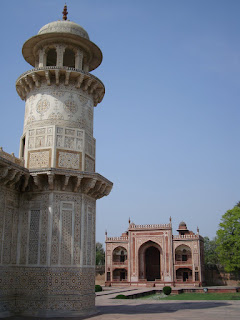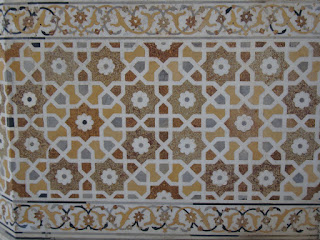
-
-
-
-
-
-
-
After two days and three nights in Delhi, we woke up early on Sunday to take the train down to Agra. Above is the New Delhi train station at 6 a.m., below is a shot of us on the train, you can see the savanah-like scenery of Uttar Pradesh in the background.
-

-
-
-
-
-
-
-
-
We arrived in Agra before 9 a.m. and got a pre-paid taxi to our hotel, the Trident Agra, where we enjoyed a fantastic breakfast buffet. It was around this time that Joe came down with a case of "Delhi Belly" which we read affects about 70% of travellers to India (!), and which kept him feeling ill for about two full days. I was lucky enough to avoid any illness on this trip, but in some ways I feel that I paid my travellers dues in the past when getting a respritory illness in China, dehydrated in Egypt, and some sort of weird 24-hour virus in London. In any case, the hotel allowed us a super-early check in, so we were able to rest up before going out for a day of sightseeing.
-

-
-
-
-
-
-
-
We liked the taxi driver and tour guide who we had from the train station, so we had them come back to pick us up around 11 a.m. and headed out to Akbar's Tomb, north of Agra. It was while driving out to the tomb that we had one of many moments that we refered to as "Indiana Jones moments". At one point on the road we came to a railroad crossing. I should first mention that driving in India is not confined to lanes, but rather is a fluid flow of motorized, animal-pulled, and human-powered vehicles that beep at each other when they pass. One can either react to this with a minor anxiety attack, or one can just look out the window and enjoy the adreneline rush of it all. So, as we approach the railroad crossing, the gates were down. We were in the flow of northbound traffic, on the left side of the road. Rather than just stop behind those in front of us as we approached the crossing, our driver, along with everyone else, decided to go around the waiting traffic to fill up the right side of the road as well. At this point, the train is wizzing by and the road is filled completely from left to right with traffic, which is maybe 15-20 cars deep. After the train passes, the gates go up, and *surprise* we are faced with a completely full road of southbound traffic, as drivers going southbound decided to do the same thing. So, everyone tries to push and inch their way forward. About 3 minutes later, I look up and there is a gas tanker sitting on the tracks going northbound who can't move due to the face-off of traffic, and directly in front of us is a donkey-cart full of vegetables, the donkey looking straight at us through the windshield. This is where my thoughts wander to the "Indiana Jones moment". If it had been a movie, another train would have approached, and we would have run from the taxi, jumping away just as the tanker exploded. (cue the theme song here) Luckily, this was only my imagination, and after a few minutes the government worker posted at the crossing came out and started directing traffic. This was probably one of the most iconic India-moments for me.
-
In any case, we arrived at Akbar's Tomb with not too much hassle, and it was spectacular!
-

-
-
-
-
-
-
-
-
-
The above and below photos are of us at the gate of the tomb, which dates from the early 1600s.
-

-
-
-
-
-
-
-
-
More of the red sandstone gate with it's amazingly detailed inlay.
-

-
-
-
-
-
-
-
After passing through the gate, there is a long walkway to the mausoleum itself, as seen below.
-

-
-
-
-
-
A closer view of the tomb. In the foreground there is a large pool, but none of the waterways were filled. The scary part of this photo is in the arch above the human-sized door at the center. The two large areas of black are bug nests. Really, really huge bug nests.
-

-
-
-
-
-
A family entering the tomb.
-

-
-
-
-
-
-
-
-
Joe inside of the tomb. The paintings were absolutely stunning and in pretty good condition. I did read that many of the lanterns in the Mughal tombs were additions by the British, and were actually made in Egypt, but I'm not sure about this particular lantern.
-

-
-
-
-
-
-
The tomb is located down a dark and slightly sloped hallway, which you can see just to the right of Joe (above). Below is the tomb itself, in a simple but large room. The attendant was chanting, which provided a nice atmosphere as his voice echoed off the walls of the tomb.
-

-
-
-
-
-
-
-
In the gardens surrounding the tomb were gazelle-like animals with really neat twisted antlers.
-

-
-
-
-
-
-
The verandas surrounding the tomb.
-

-
-
-
-
-
-
More of the area surrounding the tomb.
-

-
-
-
-
-
-
-
The gate from the interior. I think that the minarets are also a later addition, but were part of the original plan that wasn't realized in the 17th century.
-

-
-
-
-
-
-
A close up of the inlay work.
-

-
-
-
-
-
-
-
Back in the parking lot. The driver is standing next to the taxi, our guide in the passenger seat. No air conditioning on this day, but I really love the style of the car. Joe said it reminded him of the Studebaker from the Muppet Movie.
-

-
-
-
-
-
-
Our next stop was the Persian-style Chini Ka Rauza tomb, dating from the mid-17th century, and belonging to Mulla Shukrullah Shirazi, a minister in the Mughal court who was also a famous poet.
-

-
-
-
-
-
-
The tomb was located down a narrow street which ended at a foot path in the middle of a plant nursery. I have to admit I was a little skeptical when our guide told us to get out of the car in the middle of a field with no visible signage, but a 5 minute walk led us to the out of the way tomb, where we were the only visitors. Below are the amazing lapis lazuli tiles that the tomb was once covered with.
-

-
-
-
-
-
-
The painted interior dome of the tomb.
-

-
-
-
-
-
-
Our third stop of the day was Itmad-ud-Daulah, another tomb along the Yamuna River. Below is the mausoleum gate.
-

-
-
-
-
-
-
This tomb was built in the 1620s by Nur Jehan, the wife of a Mughal emperor, for her parents. It is often refered to as the "Baby Taj" as it has alot of the same design elements, such as marble and pietre dure (semi-precious stones inlaid into marble).
-

-
-
-
-
-
-
Joe and I with some of the finely detailed surface decoration of Itmad-ud-Daulah.
-

-
-
-
-
-
-
Verses from the Qur'an on the tomb walls.
-

-
-
-
-
-
-
One of the individual tombs within the larger structure.
-

-
-
-
-
-
-
-
Some of the pietre dure.
-

-
-
-
-
-
-
The interior walls were a combination of pietre dure and painted surfaces. We had to wear foot covers to protect the marble inlay on the floors.
-

-
-
-
-
-
-
-
At the main entrance to the tomb.
-

-
-
-
-
-
-
-
From this photo you can see that the inlay work continues up the minarets to the top of the structure, an amazing amount of work.
-

-
-
-
-
-
-
-
A detail of some of the geometric patterns.
-

-
-
-
-
-
A typical scene of daily life in India as we drove from the tomb to the gardens of Mehtab Bagh.
-

-
-
-
-
-
Saris laid out for sale.
-

-
-
-
-
-
A camel waits by the side of the road.
-

-
-
-
-
-
Our last stop of the day was Mehtab Bagh, a Mughal-style garden on the Yamuna River, oppositte of the Taj Mahal. Below is the beautifully pastoral view of the Taj from the garden, which had very few visitors. Most of the other garden-goers were Indian couples resting in the shade of the many trees.
-

-
-
-
-
-
The Yamuna River.
-

-
-
-
-
-
-
The two of us resting in the garden at the end of our sightseeing day. Some have theorized that the foundation that we are sitting on was the base for a second Taj, to be built of black marble and to house Shah Jahan (who built the Taj for one of his wives). There is little evidence for this though, and it seems more probable that the foundation was intended to be a pool in the garden.
-

-
-
-
-
-
At this point it was about 2:30 in the afternoon, and the temperature was quite hot, probably in the mid-90s(F)/high 30s (C), so we decided to head back to the hotel to relax, cure Joe's stomach, and spend some time by the pool.
No comments:
Post a Comment